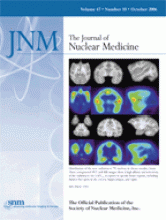REPLY: We appreciate the interest of Rolleman et al. in our 2 papers (1,2) in which we showed that infusion of the succinylated gelatin plasma expander Gelofusine (B. Braun Medical) might be useful for protection of the kidneys during peptide receptor radionuclide therapy. We fully agree that the findings of our pilot study, that the radiation dose to the kidneys will be reduced by coinfusion of Gelofusine, need to be validated in randomized controlled trials. Particularly, an intrapatient comparison between the use of lysine/arginine and Gelofusine would demonstrate the relative effectiveness of Gelofusine in reducing uptake by the kidneys. Furthermore, we take the opportunity to respond to their specific comments.
Rolleman et al. have developed a protocol in which arginine and lysine are infused to reduce uptake of radiolabeled somatostatin analogs by the kidneys. Apparently, hyperkalemia is not a major problem, probably because of the fluid load of 1 L. Still, vomiting as a side effect occurred more frequently in the infused patients as indicated by the 10% difference in vomiting rate between the infused group and the control group. Moreover, in a recent therapy study using lysine (2.5%) and arginine (2.5%) in 1 L of 0.9% NaCl to reduce uptake of 177Lu-1,4,7,10-tetraazacyclododecanetetraacetic acid Tyr3-octreotate by the kidneys, nausea and vomiting occurred in 31% and 14% of patients, respectively, despite the use of the antiemetic granisetron (3).
In animal experiments, high doses of lysine are required to induce renal failure. However, the relevance of animal models in determining nephrotoxicity and extrapolation to humans are difficult, because toxicity data generally are based on a dose of mg/kg of body weight. In general, higher doses are needed in animals to induce drug toxicity. For example, the doses of aminoglycoside antibiotics to induce nephrotoxicity in mice and rats are much higher than the doses described for humans (4). Nevertheless, the toxicity of lysine in humans has been demonstrated. ten Dam et al. compared intravenous lysine (0.44 g/kg) with intravenous arginine in healthy volunteers. Infusion of lysine increased urinary excretion of the proximal tubular injury marker β-N-acetylglucosaminidase 20- to 100-fold compared with arginine, clearly illustrating the tubulotoxic effect of lysine (5).
Gelofusine is normally applied in critically ill patients. Therefore, we believe that induction of side effects in healthy subjects and patients with normal circulation may occur even more sporadically. We have used Gelofusine in a total dose of approximately 320 mL for a 70-kg adult. The duration of the infusion was 3 h. No major effect on extracellular volume is to be expected with this rather slow infusion rate, unless applied in patients with severe renal insufficiency or heart failure. We have used blood pressure and heart rate as hemodynamic parameters to evaluate volume status. Other parameters were not determined, but there were no complaints of dyspnea, edema, or headaches.
The authors point to the risk of anaphylactic reactions to Gelofusine. The 12-fold higher incidence compared with albumin is noteworthy but must be put into perspective: Barron et al. (6) stated that the incidence of severe reactions to albumin was 5 in 100,000, meaning that Gelofusine will cause a severe reaction in 6 of every 10,000 infusions. The latter figure is comparable to the reported incidence of severe anaphylactoid reactions of 0.028%−0.15% in large studies. To reduce the risk of anaphylactoid reactions, one should specifically ask patients about anaphylaxis after vaccination or during perioperative care (7). Certainly, we cannot exclude certain risks during infusion of Gelofusine. Further studies will indicate which compound in peptide receptor radionuclide therapy with somatostatin analogs is most effective in reducing the kidney radiation dose and has acceptable side effects.







